
General Guide | Level Guide | Challenger Guide | Foraging Guide | Predator Guide | Rabbit Selling Guide | Kindling Guide | Genetics Guide | Character Contest Guide | Name Generator | Seeker Guide | Snowflake Guide | Shrooms Guide | Category Guide | HTML Guide | Crystal Cave Guide | Help Forum
Warrenz uses realistic genetics to determine a rabbit's color. Genetics come into play when kindling or applying DNA. If you
plan on doing either of those things, it can be helpful to learn a bit about genetics.
You can also read up on resources about the genetics of real life rabbits. Warrenz follows most of the same rules, although this guide will specify when it does't.
A rabbit can have up to 2 different alleles per gene. 2 different alleles will vye for dominance. The dominant allele gets expressed in the rabbit's coat color while the recessive one is 'carried' and remains hidden.
There is another type of dominance called co-dominance, which means that 2 different alleles are expressed at the same time.
Below is every gene on Warrenz, and all of the available alleles for each gene (in order from most to least dominant).
The A Gene is what determines whether or not there is a 'color pattern' on rabbits with Full Extension (from the E Gene).
Below are all of the possible alleles in the A Gene.
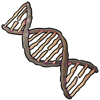
Agouti is the common 'wild' color of rabbits. It's dominant to Tan Pattern and Self.
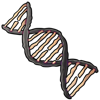
Tan pattern causes a light colored belly, chin, nostrils, and eye circtles. It's recessive to Agouti and dominant to Self.
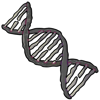
Self has no color pattern.
The B Gene determines a rabbit's 'base' color. In real life, rabbits can be either Black or Chocolate, but Warrenz has fantasy base colors like Yellow and Red.

Causes the base color to be a fantasy color dependent on a hidden modifier.
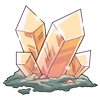
Orange happens when Red and Yellow are co-dominant together.

Purple happens when Blue and Red are co-dominant together.
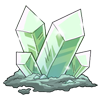
Green happens when Blue and Yellow are co-dominant together.
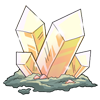
Yellow is a fantasy base color.
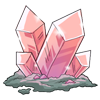
Red is a fantasy base color.

Blue is a fantasy base color.
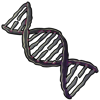
Most rabbits are black-based.
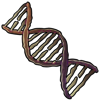
Chocolate is a brown base color that's recessive to black.
The C Gene has many interesting affects depending on the allele and is often referred to as the 'color' gene.
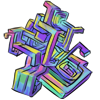
There is an additional C Gene allele found on Warrenz that causes the agouti or tan pattern areas to possibly (not always) be any fantasy color (depending on a hidden modifier).
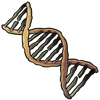
Like its name implied, Full Color means that full color of the other genes is expressed. It is dominant to all other C Gene alleles.
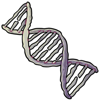
The Chinchilla allele is named after the animal, chinchilla, because it creates a similar color to those adorable little gray sand ploppers. It's like the grayscale of rabbit genetics, removing the color (saturation) from everything but the base color (chocolate will still appear chocolate-y).
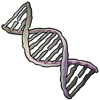
Shaded causes a low saturation 'color' pattern on a rabbit, but leaves the extremities (nose, ears, feet, and tail) as the base color. It's responsible Sable and 'Siamese cat'-like coloration depending on how other genes express.
Note: In real life, Shaded is co-dominant, but we removed this complication from Warrenz. Two copies of a Shaded allele will express the same way as one copy being expressed. You can get the dark or lighter expressions found in real life with a hidden modifier instead.
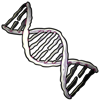
Himalayan, also known as Californian or Pointed White in rabbits, causes a similar pattern as shaded. However, their bodies will be pure white and eyes are red. In real life, their fur is heat sensitive, becoming darker in cold whether, which is what causes the extremities (colder parts of the body like toes) to usually be darker.
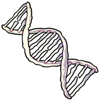
Albinism causes an all white rabbit with red eyes. In rabbits, there are no health deficits linked to albinism, which is why albino rabbits are so popular.
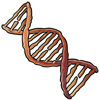
In real life, Wideband is in its own gene, but Warrenz removes the complication and has it as the most recessive allele in the C Gene. In real life, it affects the undercoat of a rabbit. On Warrenz, it causes the tan pattern area of a rabbit to be a full red color, mimicing its combined effect with rufus modifiers in real life.
The D Gene determines the diluted pigmentation of a rabbit's coat color. Of course, it doesn't affect white areas such as on Himi, Albino, or Broken.
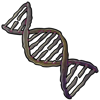
Dense is the lack of dilution in rabbits.
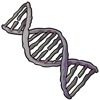
Dilute causes less pigmentation in a rabbit.
The E Gene is usually referred to as the Extension gene because it affects the hair shaft. It can do various things.

This is the norm for rabbits.
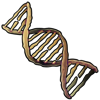
In real life, Harlequin can cause a patchwork pattern on solid-colored rabbits (no spots) and cause a spot, speckle, or blotch-like pattern on broken ones (a broken harlequin is called a tricolor). On Warrenz, harlequin works the same way, but additionally allows for the patchwork patterns on tricolor to add extra variation in the game.
The ej gene will add a harlequin pattern to a rabbit. This pattern gets cut out of the colored layered (including otter, wild, and agouti layers). Depending on whether you have ejej, eje, or ejE will change the expression of the A and E locus genes (which we'll explain next).
In addition to the harlequin pattern eje causes, there are three different ways harlequin can alter the expression of the A and E locus. Either ejej, eje, or ejE. The well-known and simple expression is ejej (two copies of harlequin). ejej force rabbits to express as non extension agouti, even though they may be neither non extension nor agouti. Even a self (aa) or tan (at_) patterned rabbit will have the color of non extension agouti if they have two copies of the harlequin gene.
When there is a single copy of ej and a copy of e (non extension), the colored parts of the rabbit will mimic non extension, also causing torting on self or tan pattern like a non extension self would (there is no torting with ejej because ejej forced a pseudo agouti expression, eje does NOT force the agouti look).
When there is a copy of full extension (E), you get a harlequinized rabbit. ejE mimics full extension expressions, turning a chestnut into a harlequinized chestnut (simply a chestnut with harlequin pattern) or making harlequinized otter. This can also result in no harlequin pattern on selfs (because full extension self has no color layers for the harlequin pattern to cut into).
Harlequin pattern can be combined with different genes in the C locus, causing colors like Magpie.
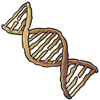
Non extension removes most of the base color from an agouti rabbit in real life (or all of it on Warrenz), causing the Orange and Fawn colors found in rabbits. On self and tan pattern, it causes torting, the Tortoise color on rabbits, which looks similar to a Non Extension agouti but with darker and more washed out coloration along with base-colored extremities (a Siamese cat-like pattern).
'En' stands for English Spotting. The En Gene is responsible for spotted rabbits in real life. It works the same on Warrenz, except that broken rabbits on Warrenz have a randomized pattern (which may take a couple seconds to load when you are generating a rabbit's image for the first time).
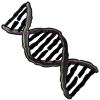
This is the norm for most rabbits.
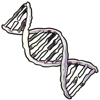
Broken is co-dominant with Solid color (lack of spots). Some rabbits will exhibit more or less white regardless of copies.
The V Gene is responsible for 'vienna' (which can cause blue eyes) and Blue Eyed White. In real life, rabbits with Vienna may or may not have Blue Eyes, but we simplief it on Warrenz so that they always have Blue Eyes. In real life, they may or may not also have white Dutch-like markings which are not present on Warrenz.
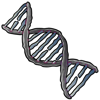
No Vienna is the norm for rabbits. Most rabbits do not have the Vienna allele.
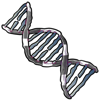
Vienna is responsible for blue eyes in rabbits. It's co-dominant with No Vienna. It can cause Blue Eyes when one copy is present. With two copies present, it causes a rabbit to be entirely white with blue eyes. Because of this, pairing two blue-eyed rabbits can result in Blue Eyed White kits.
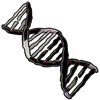
Dutch causes a unique 'Dutch pattern' of white markings, and can also cause blue eyes. In real life, it's in a separate gene, but on Warrenz, it appears in the V Locus with Vienna. Only one copy is needed (and it will appear over vienna markings if vienna is also present).
